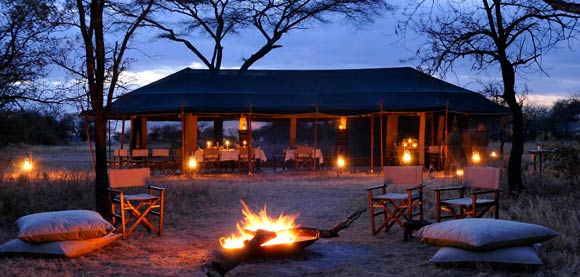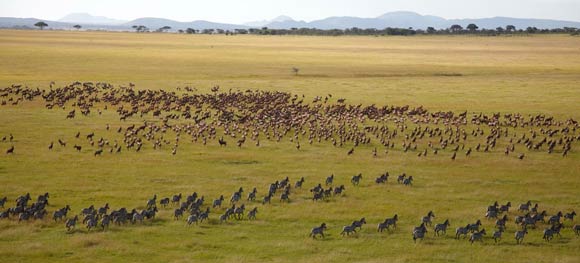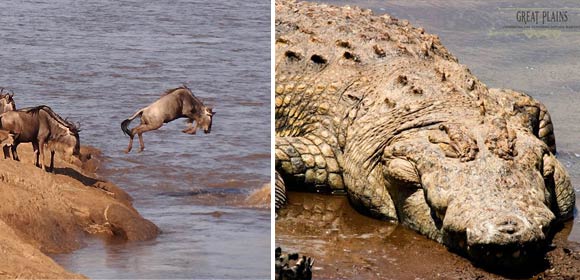Every year more than a million wildebeest, zebra and antelope chase the seasonal rain around the Serengeti and Masai Mara ecosystem. Described as “the greatest show on earth”, this annual migration holds scenes of vast plains peppered with bearded gnu, dusty columns of thousands of hooves galloping in the same direction, and life-or-death crossings of the Grumeti and Mara rivers.
Since it is the rains that trigger the migration (and weather patterns are changing), it’s tricky to pinpoint exactly when the thousand-strong herds will arrive in a particular area. However, there is a general clockwise route which they follow, and this can be used as a guideline when planning your Kenya or Tanzania migration safari.
Here are my recommendations of where to be – and the best lodges and camps to stay at – to witness the most dramatic events of this incredible journey: the calving season and river crossings.
Vast Herds & Baby Wildebeests

Wildebeest with their young and well-fed predators on the southern Serengeti plains.
When: December – March
Where: Southern Serengeti plains
What’s Happening: Following the short rains, the herds arrive on the grassy plains of Tanzania’s Southern Serengeti. Calving season begins in February (when the grazing is at its best), and most calves are born within a three-week period.
What You’ll See: Get your timing right and you’ll find yourself on game drives amongst scattered herds with plenty of newborns. The thousands of calves mean easy pickings for Africa’s top predators and the savannah plains are patrolled by well-fed lion, cheetah, leopard and hyena with an excellent chance of seeing at least one kill!

Evenings at Olakira Camp: drinks around the campfire and a candlelit dinner.
Best Places to Stay: Serengeti Under Canvas and Olakira Camp (the more luxurious option of the two) are tented camps that follow the herds, so you’re always well placed at the heart of the migration. Staying in a mobile camp really gives you the feeling of being out in the wild with evenings around the campfire and nights under canvas. But don’t expect to rough it: each tent has a comfortable bed, fine linen and a hot bucket shower.
Grumeti River Crossing & Private Reserve

Herds of wildebeest and zebra on the grassy plains of the Singita Grumeti Reserve
When: June – July
Where: Western Serengeti & Grumeti Reserve
What’s Happening: Come May the rains have stopped, the grazing dried up, and the herds begin their trek northwards. Small, scattered groups merge into a thundering column stretching from horizon to horizon, as the wildebeest gallop towards the greener pastures of Kenya’s Masai Mara Reserve. The column splits with the main group heading into the western corridor, and by June they arrive at their first major obstacle: the Grumeti River.
What You’ll See: Travel in June and you’re likely to see the herds gathered on the bank of the Grumeti River, waiting for the first brave beasts to cross. Although not quite as dramatic as the Mara River crossing further north, the Grumeti is deep in places (especially after good rains), and the presence of enormous crocodiles makes the animals understandably skittish.
Once safely on the other side, the herds continue their journey through the Singita Grumeti – a privately owned reserve known for its luxurious lodges and excellent away-from-the-crowds game viewing.

Singita Sasakwa Lodge: elegant accommodation, fine dining and ever-present Serengeti views.
Best Places to Stay: Grumeti Serengeti Tented Camp is a comfortable tented camp set right at the water’s edge, close to key Grumeti River crossing points. For an exclusive safari experience, I’d highly recommend Singita Sasakwa Lodge (in the Grumeti Reserve) which has a turn-of-the-century manor house and nine guest cottages, each with their own infinity swimming pool and superb views over the Serengeti plains.
The Main Event: The Mara River Crossing

Thousands of wildebeest crossing the Mara River (photo: Sayari Camp)

Dramatic leaps and Jurassic-sized crocs: the drama of the Mara River crossings
When: August – October
Where: Northern Serengeti & Masai Mara
What’s Happening: In August the herds are in the Northern Serengeti, and by September they have reached their biggest obstacle, the wide Mara River. This is an excellent time to see the herds (particularly from late August through to late September) with large numbers of animals and frequent river crossings.
What You’ll See: The migration herds crossing the Mara River is without doubt one of the most spectacular events on the wildlife calendar. Watch the thousands of animals waiting to cross, dramatic leaps into the water, bellowing black columns forging their way across the fast-flowing river, weak or struggling animals being picked off by Jurassic-sized crocodiles, and the desperate scramble of those who make it up the opposite river bank.

Inside one of the expansive tented suites at Sayari Camp, in the northern Serengeti
Best Place to Stay: To be at the right place at the right time, you need to book early. This is an understandably popular event. A few favourites are Mara Plains Camp, a small tented camp in a private Masai Mara Conservancy; Sayari Camp, an award-winning tented camp in a remote region of the Northern Serengeti; and Entim Camp, a back-to-basics tented camp that’s just about as close to the action as you can get.
Travel Notes:
As mentioned, the migration is driven by rain and you can’t always predict the weather. For this reason it’s a good idea to increase your chances by staying at several different locations, based on where the herds should be (or could be) at that particular time.
And if you are considering a migration safari, contact one of our travel experts and they’ll be able to help you with more information.
